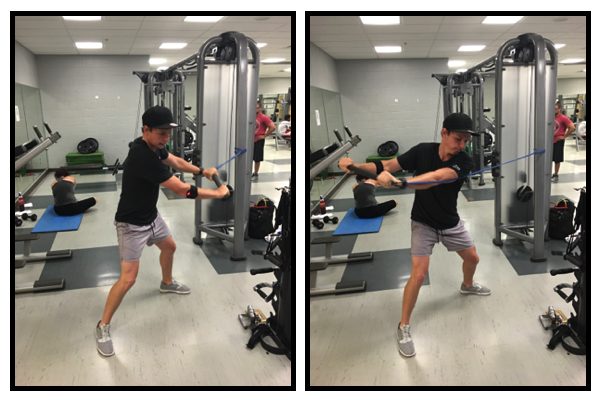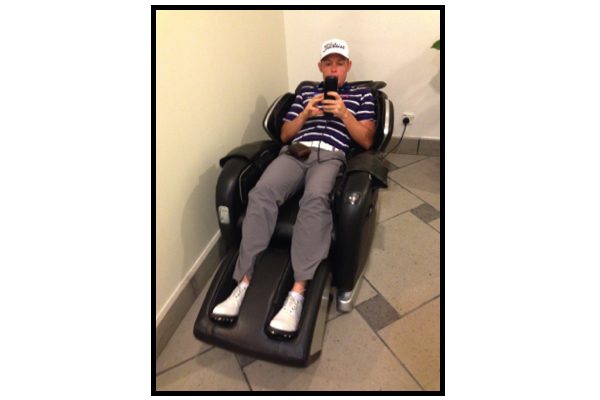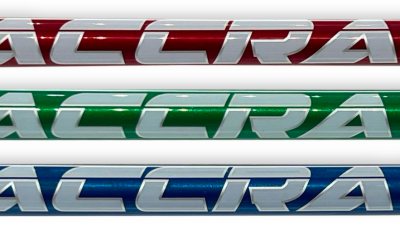Instruction
5 things you can learn from Cameron Smith’s physical preparation

Cam Smith, who just finished T3 at The Northern Trust, has made a lot of progress from when we first started working together. Not only is he now top 50 in the world, he has progressed from a scrawny teen into a well rounded golf athlete. At age 16 he was weak, tight, had some alarming postural adaptations from golf and was in pain and discomfort in a number of areas.
I would like to share with you what I consider to be the 5 areas that the competitive club golfer can learn from Cam’s approach to physical preparation. If implemented properly these will not only help your golf but benefit your long-term musculo-skeletal health too.
Cam’s approach is particularly relatable and applicable to the club golfer because he isn’t the biggest guy, or the most gifted athlete, or the hardest worker. Cam likes to keep things simple and use practice and training approaches that can be completed in a short amount of time with the minimum of fuss (leaving more time for messing around on the range apparently!)
A selection from Cam’s large repertoire of comedy golf swings
1) Stick to the Plan
Cam doesn’t wander from the prescribed plan; this is for three main reasons. Firstly he wants to avoid the excessive post exercise soreness that prohibits him from practicing and performing effectively. Sticking to familiar exercises and loads helps ensure this. Secondly, performing the same exercises allows him time to get familiar and comfortable with the technique, ensuring absolute best form and resultant outcome. Lastly, golf is a tough mental sport especially at the very elite level. Being able to go into the gym and carry out a familiar routine means that there is no excess mental energy being used up unnecessarily.
How you can apply this – find a good training program and stick to it. Only change up exercises when performance isn’t a priority (e.g. off season).
Banded back squats have been a staple for off season training, great for power development.
2) Warm Up Consistently
Cam recognizes the importance of warming up properly to not only prevent injury, but also help ensure he is moving correctly. His 15-minute routine of self-massage, stretch and posture setting is quite literally a daily habit. Pre tournament rounds, it’s also a great time to get his head in the right place and start mentally preparing for the upcoming challenge. The equipment used is a vibrating foam roller and massage ball (both made by hyperice) and the GravityFit TPro.
How you can apply this – Get yourself some basic warm up equipment, identify the key areas to release / stretch / activate and allocate 15 minutes before you play to go through the routine.
Cam warming up at the Bay Hill Invitational, 2017
3) Train for Specific Power
The keys to hitting the ball a long way are widely considered to be combination of vertical thrust and rotational speed. Since 2015 we have focused specifically on training these areas through jump variations along with rotating against resistance. The jump variations progress from small drop jumps to squat jumps with 20kg to trap bar jumps with as much as 60kg. The rotational speed approach doesn’t change much, normally working with a strong resistance band that challenges Cam to try to move at around the same speed he swings driver. This contributed to Cam placing third on tour for distance gained from 2016-2017 season.
We use an accelerometer to quantify progress and drive intent by measuring speed, jump height and power output. If you are tech minded and like your training easily quantified then check out the Push Band by Train With Push.
How you can apply this – incorporate basic jump movements into your gym sessions along with some fast rotational work against resistance bands. Just remember to work on your landing mechanics (land soft) to minimize the risk of injury and work up slowly to top speeds for the rotations.

Cam working hard on his rotational speed (push band on his arm)
4) Train Posture and Stability
To my knowledge, GravityFit make the only equipment designed to specifically train the deep muscle system responsible for holding posture and stabilising joints. The combination of axial load and the immediate feedback system means that when using the GravityFit equipment Cam is always aware of when he is in good posture and what that feels like. We combine using the equipment with simple movements that challenge his ability to maintain balance and posture. This forms part of daily routine that can be done around the house, in the gym or on the range.
How you can apply this – Start training your posture and deep muscle system, preferably using GravityFit equipment and exercises. Your joints and golf swing will thank you for it.
Cam is aiming to absorb the landing load softly whilst maintaining stability in spine and shoulders
5) Know When to Rest
The physical, mental and emotional demands of a tournament week make it tricky to continue to train with the same volume and intensity as usual. This makes it the ideal time to reduce the intensity and volume of gym work, focusing on posture, speed and mobility. I will often prescribe a watered down version of the usual program, reducing reps, sets and load whilst still focusing on great technique.
How you can apply this – moderate your training load to suit your performance needs. Try doing the heavy stuff earlier in the week, leaving your fresher for the weekend.

Cam making the most of the massage chair in the locker room at CIMB Classic, 2016
My recommendations might seem pretty simple, and with good reason; golf is a complex, frustrating and often confusing game. I believe that golfer’s training should be straight forward, easy to implement and repeatable. In the is un-predictable sport, some consistency around physical preparation can go a long way to minimizing variability in performance.
- LIKE99
- LEGIT15
- WOW3
- LOL1
- IDHT2
- FLOP1
- OB1
- SHANK4
Instruction
The Wedge Guy: The easiest-to-learn golf basic

My golf learning began with this simple fact – if you don’t have a fundamentally sound hold on the golf club, it is practically impossible for your body to execute a fundamentally sound golf swing. I’m still a big believer that the golf swing is much easier to execute if you begin with the proper hold on the club.
As you might imagine, I come into contact with hundreds of golfers of all skill levels. And it is very rare to see a good player with a bad hold on the golf club. There are some exceptions, for sure, but they are very few and very far between, and they typically have beat so many balls with their poor grip that they’ve found a way to work around it.
The reality of biophysics is that the body moves only in certain ways – and the particulars of the way you hold the golf club can totally prevent a sound swing motion that allows the club to release properly through the impact zone. The wonderful thing is that anyone can learn how to put a fundamentally sound hold on the golf club, and you can practice it anywhere your hands are not otherwise engaged, like watching TV or just sitting and relaxing.
Whether you prefer an overlap, interlock or full-finger (not baseball!) grip on the club, the same fundamentals apply. Here are the major grip faults I see most often, in the order of the frequency:
Mis-aligned hands
By this I mean that the palms of the two hands are not parallel to each other. Too many golfers have a weak left hand and strong right, or vice versa. The easiest way to learn how to hold the club with your palms aligned properly is to grip a plain wooden ruler or yardstick. It forces the hands to align properly and shows you how that feels. If you grip and re-grip a yardstick several times, then grip a club, you’ll see that the learning curve is almost immediate.
The position of the grip in the upper/left hand
I also observe many golfers who have the butt of the grip too far into the heel pad of the upper hand (the left hand for right-handed players). It’s amazing how much easier it is to release the club through the ball if even 1/4-1/2″ of the butt is beyond the left heel pad. Try this yourself to see what I mean. Swing the club freely with just your left hand and notice the difference in its release from when you hold it at the end of the grip, versus gripping down even a half inch.
To help you really understand how this works, go to the range and hit shots with your five-iron gripped down a full inch to make the club the same length as your seven-iron. You will probably see an amazing shot shape difference, and likely not see as much distance loss as you would expect.
Too much lower (right) hand on the club
It seems like almost all golfers of 8-10 handicap or higher have the club too far into the palm of the lower hand, because that feels “good” if you are trying to control the path of the clubhead to the ball. But the golf swing is not an effort to hit at the ball – it is a swing of the club. The proper hold on the club has the grip underneath the pad at the base of the fingers. This will likely feel “weak” to you — like you cannot control the club like that. EXACTLY. You should not be trying to control the club with your lower/master hand.
Gripping too tightly
Nearly all golfers hold the club too tightly, which tenses up the forearms and prevents a proper release of the club through impact. In order for the club to move back and through properly, you must feel that the club is controlled by the last three fingers of the upper hand, and the middle two fingers of the lower hand. If you engage your thumbs and forefingers in “holding” the club, the result will almost always be a grip that is too tight. Try this for yourself. Hold the club in your upper hand only, and squeeze firmly with just the last three fingers, with the forefinger and thumb off the club entirely. You have good control, but your forearms are not tense. Then begin to squeeze down with your thumb and forefinger and observe the tensing of the entire forearm. This is the way we are made, so the key to preventing tenseness in the arms is to hold the club very lightly with the “pinchers” — the thumbs and forefingers.
So, those are what I believe are the four fundamentals of a good grip. Anyone can learn them in their home or office very quickly. There is no easier way to improve your ball striking consistency and add distance than giving more attention to the way you hold the golf club.
More from the Wedge Guy
- The Wedge Guy: Golf mastery begins with your wedge game
- The Wedge Guy: Why golf is 20 times harder than brain surgery
- The Wedge Guy: Musings on the golf ball rollback
- LIKE85
- LEGIT13
- WOW5
- LOL1
- IDHT0
- FLOP4
- OB1
- SHANK8
Instruction
Clement: Stop ripping off your swing with this drill!

Not the dreaded headcover under the armpit drill! As if your body is defective and can’t function by itself! Have you seen how incredible the human machine is with all the incredible feats of agility all kinds of athletes are accomplishing? You think your body is so defective (the good Lord is laughing his head off at you) that it needs a headcover tucked under the armpit so you can swing like T-Rex?
- LIKE0
- LEGIT2
- WOW2
- LOL0
- IDHT0
- FLOP0
- OB0
- SHANK2
Instruction
How a towel can fix your golf swing

This is a classic drill that has been used for decades. However, the world of marketed training aids has grown so much during that time that this simple practice has been virtually forgotten. Because why teach people how to play golf using everyday items when you can create and sell a product that reinforces the same thing? Nevertheless, I am here to give you helpful advice without running to the nearest Edwin Watts or adding something to your Amazon cart.
For the “scoring clubs,” having a solid connection between the arms and body during the swing, especially through impact, is paramount to creating long-lasting consistency. And keeping that connection throughout the swing helps rotate the shoulders more to generate more power to help you hit it farther. So, how does this drill work, and what will your game benefit from it? Well, let’s get into it.
Setup
You can use this for basic chip shots up to complete swings. I use this with every club in my bag, up to a 9 or 8-iron. It’s natural to create incrementally more separation between the arms and body as you progress up the set. So doing this with a high iron or a wood is not recommended.
While you set up to hit a ball, simply tuck the towel underneath both armpits. The length of the towel will determine how tight it will be across your chest but don’t make it so loose that it gets in the way of your vision. After both sides are tucked, make some focused swings, keeping both arms firmly connected to the body during the backswing and follow through. (Note: It’s normal to lose connection on your lead arm during your finishing pose.) When you’re ready, put a ball in the way of those swings and get to work.

Get a Better Shoulder Turn
Many of us struggle to have proper shoulder rotation in our golf swing, especially during long layoffs. Making a swing that is all arms and no shoulders is a surefire way to have less control with wedges and less distance with full swings. Notice how I can get in a similar-looking position in both 60° wedge photos. However, one is weak and uncontrollable, while the other is strong and connected. One allows me to use my larger muscles to create my swing, and one doesn’t. The follow-through is another critical point where having a good connection, as well as solid shoulder rotation, is a must. This drill is great for those who tend to have a “chicken wing” form in their lead arm, which happens when it becomes separated from the body through impact.
In full swings, getting your shoulders to rotate in your golf swing is a great way to reinforce proper weight distribution. If your swing is all arms, it’s much harder to get your weight to naturally shift to the inside part of your trail foot in the backswing. Sure, you could make the mistake of “sliding” to get weight on your back foot, but that doesn’t fix the issue. You must turn into your trial leg to generate power. Additionally, look at the difference in separation between my hands and my head in the 8-iron examples. The green picture has more separation and has my hands lower. This will help me lessen my angle of attack and make it easier to hit the inside part of the golf ball, rather than the over-the-top move that the other picture produces.


Stay Better Connected in the Backswing
When you don’t keep everything in your upper body working as one, getting to a good spot at the top of your swing is very hard to do. It would take impeccable timing along with great hand-eye coordination to hit quality shots with any sort of regularity if the arms are working separately from the body.
Notice in the red pictures of both my 60-degree wedge and 8-iron how high my hands are and the fact you can clearly see my shoulder through the gap in my arms. That has happened because the right arm, just above my elbow, has become totally disconnected from my body. That separation causes me to lift my hands as well as lose some of the extension in my left arm. This has been corrected in the green pictures by using this drill to reinforce that connection. It will also make you focus on keeping the lead arm close to your body as well. Because the moment either one loses that relationship, the towel falls.


Conclusion
I have been diligent this year in finding a few drills that target some of the issues that plague my golf game; either by simply forgetting fundamental things or by coming to terms with the faults that have bitten me my whole career. I have found that having a few drills to fall back on to reinforce certain feelings helps me find my game a little easier, and the “towel drill” is most definitely one of them.
- LIKE12
- LEGIT2
- WOW2
- LOL0
- IDHT0
- FLOP2
- OB0
- SHANK8
-

 19th Hole6 days ago
19th Hole6 days agoDave Portnoy places monstrous outright bet for the 2024 Masters
-

 19th Hole2 weeks ago
19th Hole2 weeks agoThings got heated at the Houston Open between Tony Finau and Alejandro Tosti. Here’s why
-

 19th Hole7 days ago
19th Hole7 days agoTiger Woods arrives at 2024 Masters equipped with a putter that may surprise you
-

 19th Hole2 weeks ago
19th Hole2 weeks agoReport: Tiger Woods has ‘eliminated sex’ in preparation for the 2024 Masters
-

 19th Hole2 days ago
19th Hole2 days agoTwo star names reportedly blanked Jon Rahm all week at the Masters
-

 19th Hole22 hours ago
19th Hole22 hours agoNeal Shipley presser ends in awkward fashion after reporter claims Tiger handed him note on 8th fairway
-

 19th Hole2 weeks ago
19th Hole2 weeks agoAddiction, spinal fusion, and scam artists – Everything Anthony Kim revealed in candid interview with David Feherty
-

 19th Hole2 weeks ago
19th Hole2 weeks agoAnthony Kim says doctors told him that he ‘may not have much time left’ ahead of LIV return


























Robin
Aug 28, 2018 at 10:38 am
As a former boxer and marine ,I burned out my body years ago.
I have to many aftermarket parts in me know. To do any of that work with out a part snapping.
doesnotno
Aug 28, 2018 at 8:50 am
“If implemented properly these will not help your golf”
Missing the word “only”?
Tom
Aug 27, 2018 at 6:39 pm
I recommend 3 Advil, 2 beers and 2 cigars over 18 holes…..works great!
Daniel Forbes
Sep 7, 2018 at 5:50 am
And an early grave
fox_todd
Aug 27, 2018 at 4:50 pm
As an exercise physiologist I appreciate the simplicity. Too many try to make it too complicated. Great write up.